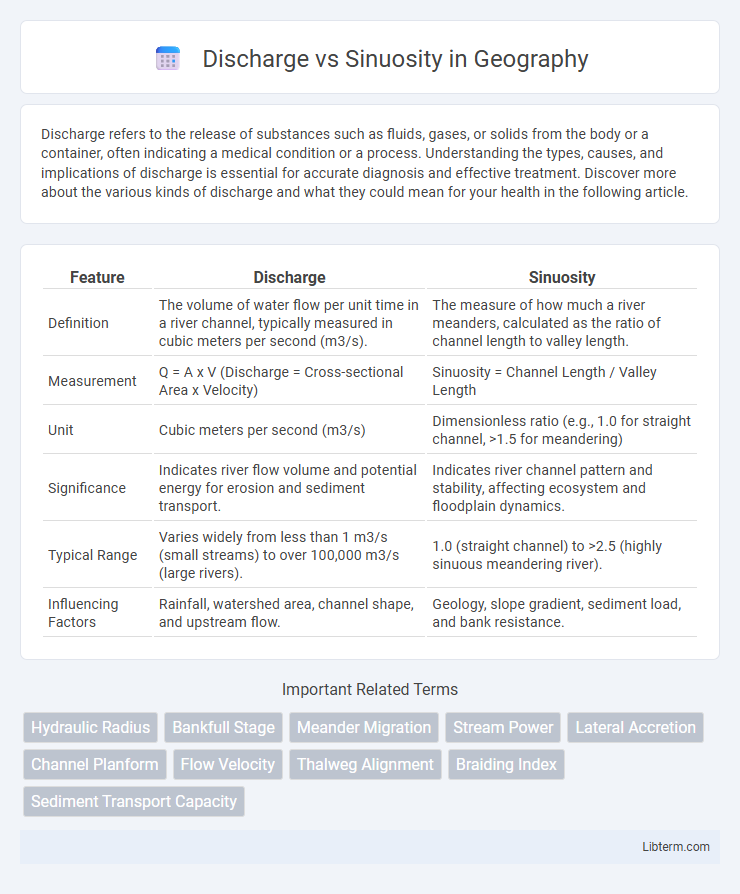Discharge refers to the release of substances such as fluids, gases, or solids from the body or a container, often indicating a medical condition or a process. Understanding the types, causes, and implications of discharge is essential for accurate diagnosis and effective treatment. Discover more about the various kinds of discharge and what they could mean for your health in the following article.
Table of Comparison
| Feature | Discharge | Sinuosity |
|---|---|---|
| Definition | The volume of water flow per unit time in a river channel, typically measured in cubic meters per second (m3/s). | The measure of how much a river meanders, calculated as the ratio of channel length to valley length. |
| Measurement | Q = A x V (Discharge = Cross-sectional Area x Velocity) | Sinuosity = Channel Length / Valley Length |
| Unit | Cubic meters per second (m3/s) | Dimensionless ratio (e.g., 1.0 for straight channel, >1.5 for meandering) |
| Significance | Indicates river flow volume and potential energy for erosion and sediment transport. | Indicates river channel pattern and stability, affecting ecosystem and floodplain dynamics. |
| Typical Range | Varies widely from less than 1 m3/s (small streams) to over 100,000 m3/s (large rivers). | 1.0 (straight channel) to >2.5 (highly sinuous meandering river). |
| Influencing Factors | Rainfall, watershed area, channel shape, and upstream flow. | Geology, slope gradient, sediment load, and bank resistance. |
Introduction to Discharge and Sinuosity
Discharge measures the volume of water flowing through a river channel per unit time, typically expressed in cubic meters per second (m3/s), reflecting the river's capacity to transport water and sediment. Sinuosity quantifies the degree of meandering in a river, calculated as the ratio of the channel length to the straight-line distance between two points, influencing flow dynamics and erosion patterns. Understanding the relationship between discharge and sinuosity is essential for predicting river behavior, flood risks, and sediment deposition processes.
Understanding River Discharge
River discharge, measured in cubic meters per second, quantifies the volume of water flowing through a river channel over time, directly influencing channel morphology and sinuosity. Higher discharge often results in increased erosion and sediment transport, leading to more pronounced meanders and greater sinuosity in river courses. Understanding the relationship between discharge variability and sinuosity aids in predicting river behavior and managing flood risks.
Defining Channel Sinuosity
Channel sinuosity is defined as the ratio of the channel length to the valley length, reflecting the degree of meandering in a river system. Discharge influences sinuosity by altering flow velocity and sediment transport, which can either enhance meander growth or cause channel straightening. Quantitative analysis of discharge and channel sinuosity helps in predicting river dynamics and sediment deposition patterns.
Factors Influencing River Discharge
River discharge is primarily influenced by precipitation volume, catchment area size, and soil infiltration capacity, which collectively affect the amount of water flowing in a river channel. Sinuosity, or the meandering nature of a river, impacts flow velocity and sediment transport, indirectly shaping discharge patterns by altering channel resistance and flow path length. Vegetation cover and land use changes also play critical roles in modulating discharge through evapotranspiration rates and surface runoff characteristics.
Causes of Channel Sinuosity
Channel sinuosity is primarily influenced by discharge variability, sediment load, and bank resistance. High discharge fluctuations promote meandering by eroding outer banks and depositing sediment on inner banks, enhancing curvature. Reduced bank stability from vegetation loss or weak cohesive soils further amplifies channel sinuous patterns.
Relationship Between Discharge and Sinuosity
River discharge strongly influences sinuosity by affecting flow velocity and sediment transport, which shape channel meanders. High discharge can increase erosion on outer banks, promoting greater sinuosity, while low discharge often results in straighter channels with reduced sinuosity. This dynamic interplay between discharge volume and channel curvature controls river morphology and floodplain development.
Impacts of Discharge on River Morphology
Discharge directly influences river morphology by shaping channel patterns and sinuosity levels, where higher discharge typically increases sediment transport capacity, resulting in more pronounced meanders and enhanced lateral erosion. Variations in discharge regimes modify flow velocity and shear stress, which control sediment deposition and channel migration, thereby impacting sinuosity development. Understanding discharge fluctuations is crucial for predicting river dynamics, floodplain evolution, and habitat diversity in fluvial environments.
Effects of Sinuosity on Water Flow
Sinuosity significantly affects water flow by increasing the channel length and reducing flow velocity, which enhances sediment deposition and promotes diverse aquatic habitats. Higher sinuosity induces greater hydraulic resistance, leading to energy dissipation and reduced erosion downstream. This dynamic interaction influences floodplain connectivity and sediment transport, crucial for river ecosystem stability and flood risk management.
Measuring Discharge and Sinuosity in Rivers
Measuring discharge in rivers involves calculating the volume of water flowing through a cross-section per unit time, typically expressed in cubic meters per second (m3/s) using flow meters or the velocity-area method. Sinuosity, defined as the ratio of the river channel length to the valley length, is measured by tracing the channel path on maps or satellite imagery to quantify river meandering. Both discharge and sinuosity metrics play critical roles in hydrological modeling and river management, influencing sediment transport, flood risk assessment, and habitat diversity.
Case Studies: Discharge vs Sinuosity in Different River Systems
Case studies analyzing discharge versus sinuosity reveal distinct relationships across various river systems, demonstrating that higher discharge rivers tend to exhibit lower sinuosity due to increased flow energy and channel stability. For instance, the Amazon River, with its massive discharge averaging about 209,000 cubic meters per second, maintains relatively low sinuosity compared to smaller rivers like the Meander River in the United States, where lower discharge promotes higher sinuosity through increased meander formation. These observations underscore the complexity of hydrodynamic processes influencing channel morphology and the importance of discharge magnitude in shaping sinuosity in diverse fluvial environments.
Discharge Infographic

 libterm.com
libterm.com